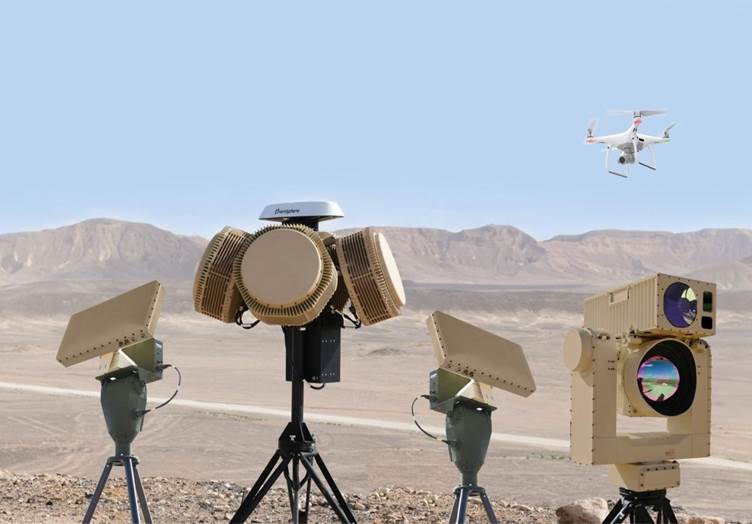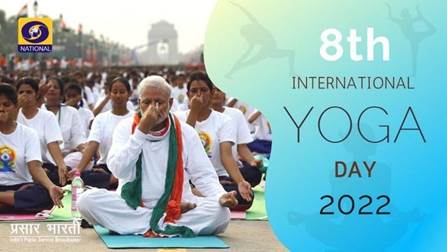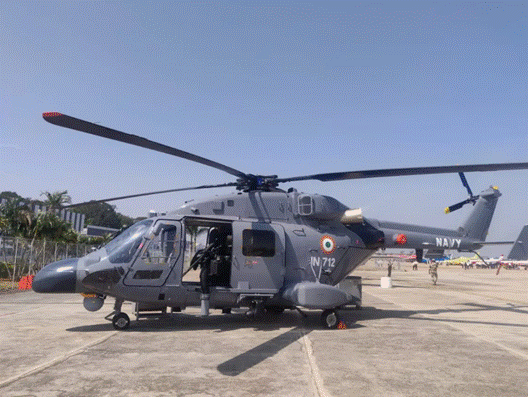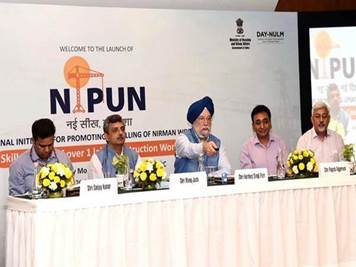AIR Discussions (June 3rd Week)
AIR SPOTLIGHT
DRONE TECHNOLOGY – A BOON FOR MANKIND

Disclaimer: Copyright infringement not intended.
Context
- Drones are Unmanned Aerial Vehicles (UAVs) or Remotely Piloted Aerial Systems (RPAS) that are controlled either by a pilot on the ground or with the help of technology.
- India has observed an increasing focus on drones over the last couple of years.
- The annual Beating Retreat Ceremony held on January 29 2022 marks the conclusion of Republic Day celebrations and saw the first of its kind show of nearly 1000 Made-in-India
- The drone space has got renewed focus with the Drone Rules of 2021 which made paperwork lighter and a digital Skype Platform Drones are Unmanned Aerial Vehicles (UAVs) or Remotely Piloted Aerial Systems (RPAS) that are controlled either by a pilot on the ground or with the help of technology have been catalysts with investors coming forward for the sector.
Drone Rules 2021
- Based on a premise of trust, self-certification and non-intrusive
- Designed to usher in an era of super-normal growth while balancing safety and security considerations.
- Several approvals abolished: unique authorisation number, unique prototype identification number, certificate of manufacturing and airworthiness, certificate of conformance, certificate of maintenance, import clearance, acceptance of existing drones, operator permits, authorisation of R&D organisation, student remote pilot licence, remote pilot instructor authorisation, drone port authorisation etc.
- Number of forms reduced from 25 to 5.
- Types of fees reduced from 72 to 4.
- Quantum of fee reduced to nominal levels and delinked with the size of the drone. For instance, the fee for a remote pilot license fee has been reduced from INR 3000 (for large drones) to INR 100 for all categories of drones; and is valid for 10 years.
- Digital sky platform being developed as a user-friendly online single-window system. There will be minimal human interface and most permissions will be self-generated.
- Interactive drone airspace map with red and yellow zones shall be displayed.
- No permission is required for operating drones in green zones.
- Yellow zone, where ATC permission is required, has been reduced from 45 km to 12 km from the airport perimeter.
- No remote pilot licence required for micro drones (for non-commercial use) and nano drones.
- No requirement of Type Certificate, unique identification number and remote pilot licence by R&D entities operating drones on own or rented premises, located in a green zone.
- Import of drones to be regulated by DGFT.
- Requirement of import clearance from DGCA abolished.
- No security clearance is required before issuance of any registration or license.
- Coverage of drones under drone rules, 2021 increased from 300 kg to 500 kg. This will cover drone taxis
- DGCA shall prescribe drone training requirements, oversee drone schools and provide pilot licences online.
- No restriction on foreign ownership in Indian drone companies.
- Remote pilot licence to be issued by DGCA within 15 days of the pilot receiving the remote pilot certificate from an authorised drone school through the digital sky platform.
- Testing of drones for issuance of Type Certificate to be carried out by Quality Council of India or authorised testing entities.
- Type Certificate required only when a drone is to be operated in India. Importing and manufacturing drones purely for exports are exempt from type certification and unique identification numbers.
- Nano and model drones (made for research or recreation purposes) are exempt from type certification.
- Manufacturers and importers may generate their drones’ unique identification number on the digital sky platform through the self-certification route.
- Easier process specified for transfer and deregistration of drones through the digital sky platform.
- Drones present in India on or before 30 Nov 2021 will be issued a unique identification number through the digital sky platform provided, they have a DAN (Device Acknowledgment Number), a GST-paid invoice and are part of the list of DGCA-approved drones.
- Standard operating procedures (SOP) and training procedure manuals (TPM) will be prescribed by DGCA on the digital sky platform for self-monitoring by users. No approvals are required unless there is a significant departure from the prescribed procedures.
- Safety and security features like ‘No Permission – No Takeoff’ (NPNT), real-time tracking beacon, geo-fencing etc. to be notified in future. A six-month lead time will be provided to the industry for compliance.
- Maximum penalty for violations reduced to INR One lakh. It was several lakhs earlier.
- Drone corridors will be developed for cargo deliveries.
- Drone promotion council to be set up by the government with participation from academia, start-ups and other stakeholders to facilitate a growth-oriented regulatory regime.
Classification of unmanned aircraft systems
The unmanned aircraft system shall, based on the maximum all-up weight including payload, be classified as follows:
- Nano unmanned aircraft system: weighing less than or equal to 250 grams;
- Micro unmanned aircraft system: weighing more than 250 grams, but less than or equal to Two kilograms;
- Small unmanned aircraft system: weighing more than Two kilograms, but less than or equal to 25 kilograms;
- Medium unmanned aircraft system: weighing more than 25 kilograms, but less than or equal to 150 kilograms.
- Large unmanned aircraft system: weighing more than 150 kilograms.
India has witnessed its biggest drone festival. Prime Minister Narendra Modi inaugurated the two-day festival which has seen the attendance of over 1600 delegates and the participation of over 80 companies which are currently involved in drone manufacturing and drone technology.
What is the entire renewed focus on the drone sector by the Indian government in the context of the current geopolitical situation?
- Drones are not a new concept, just like the development of aeroplanes took place in 1907 and it took almost 50 years for them to commercialise aeroplanes. Similarly, drones have been started by many years ago but nowadays it has got their path and is attracted many industries.
- For example, drones would be useful for agriculture in case of spraying pesticides or growth material or finding the health of the crop.
- Toto brings a change in agriculture technology, drones are a powerful tool which could be able to identify the disease in the crop, so we can easily find out in a particular crop which part has been affected in terms of altitude and longitude.
- Using a certified drone pilot, we can operate the drones in the agriculture sector. The Government of India in its initiative under the SVAMITVA (Survey of Villages and Mapping with Improvised Technology in Village Areas) scheme almost 6.5 lakh villages have been covered using drone technology.
- Under this high-resolution picture will be taken, these pictures will be converted to geotagging images and will further converted into maps. The map again will be matched with the existing pictures. And a digital map will be developed.
- Other major uses of the drone are in organ transportation under medical applications and may be for logistic support in case of emergency, applications for deforestation and another important application area for this technology is the Kisan drone.
- India is seeking a lot of initiatives in developing Kisan drones, there is also planning to put a manufacturing plant by 2025.
The government has rightly pointed out that the drones have found their usage across various fields whether it’s digital mapping, mining logistics, e-commerce, health care facilities, defence, agriculture and also Kisan drone which also find mentioned in the Union Budget 2022-23, where the finance minister held that Kisan drone will be promoted for crop assessment, digitization of land records and spraying of insecticides & nutrients.
In this regard, there is an expectation that there is an estimate that India has about six lakh drones currently and this figure is expected to grow 6 to 8 times over the next five to eight years. Similarly, the revenue or the turnover of drone manufacturing industries is also set to cross 15,000 crore rupees by 2026.
Does India have enough companies, enough potential, to meet this kind of demand across different fields whether it’s health care, defence or agriculture?
- At present India does not have that much infrastructure to support manufacturing companies. What is happening now is, that companies are buying from foreign entities mostly from China and Taiwan.
- So, to meet Indian demands, there is a need for companies to come forward and create their manufacturing facilities to create their R&D facilities and the government of India is also taking measures of creating manpower in this field.
- Toto increase the use of Kisan drones, the government of India is taking various measures:
- Whenever a farmer or any other person is flying a drone, the respective should have a drone pilot license (announced in Drone Rules 2021) also called a remote pilot certificate.
- Another point where the government has taken the initiative is the drone certification, (as per Drone Rules, 2021) there are a lot of companies that are importing and integrating the parts of drones; hence the manufacturer will need to get the UIN (Unique Identification Number). The drone certification is of various types:
- Remote pilot certification
- Thermal imaging certification
- Aerial mapping and 3D modelling certification
- Industrial inspection certification
- The certification will be approved by the Quality Council of India (QCI).
- Big private players coming in, by 2025 India will be able to develop good infrastructure for drone manufacturers and will be able to give a certificate through remote pilot training organisation by 2030.
- Prime Minister envisioned India to become the drone hub and generate 10 to 15 lakhs job opportunities.
It is estimated that the drone service industry is expected to generate over 5 lakh jobs in three years, in that regard the government had also come up with a PLI scheme worth Rs.120 crores where the incentive for a manufacturer of drones and drone components shall be as high as 20% of the value addition to boost manufacturing in India. The government is also talking about the space for drones, anti-drone and drone taxis.
What is the timeline by which India can expect to see more manufacturing of counter-drone and flying taxis in India?
- Drones are still not flooded in Indian markets, India is majorly emphasising civilian use, whereas the anti-drone technology is for military warfare, so the manufacturing of anti-drone will take time.
- On that note, Drone Rule 2021 has categorised flying zones for civilian use:
- “Red Zone” means the airspace of defined dimensions, above the land areas or territorial waters of India, or any installation or notified port limits specified by the Central Government beyond the territorial waters of India, within which unmanned aircraft system operations shall be permitted only by the Central Government.
- “Yellow Zone” means the airspace of defined dimensions above the land areas or territorial waters of India within which unmanned aircraft system operations are restricted and shall require permission from the concerned air traffic control authority. The airspace above 400 feet or 120 metres in the designated green zone and the airspace above 200 feet or 60 metres in the area located between the lateral distance of 8 kilometres and 12 kilometres from the perimeter of an operational airport, shall be designated as a yellow zone.
- “Green Zone” means the airspace of defined dimensions above the land areas or territorial waters of India, up to a vertical distance of 400 feet or 120 metres that have not been designated as a red zone or yellow zone in the airspace map for unmanned aircraft system operations and the airspace up to a vertical distance of 200 feet or 60 metres above the area located between a lateral distance of 8 kilometres and 12 kilometres from the perimeter of an operational airport.
https://newsonair.gov.in/Spotlight.aspx#
https://t.me/+hJqMV1O0se03Njk9
NEWS IN BRIEF: PRELIMS SPECIAL
International Yoga Day

Disclaimer: Copyright infringement not intended.
Context
- The 8th edition of International Day of Yoga is being celebrated on 21st June 2022.
- Prime Minister Narendra Modi will lead the mass Yoga demonstration at Mysuru in Karnataka.
- Over 15 thousand participants are expected to do yoga along with the Prime Minister.
- Crores of people will participate in various International Day of Yoga programs being organized in India and the world.
- The theme of this year’s International Day of Yoga is ‘Yoga for Humanity’.
- As the International Day of Yoga is falling in the year of ‘Azadi Ka Amrit Mahotsav', Yoga Day is being celebrated in 75 iconic places across the country.
- As part of the Guardian Ring initiative, the movement of the Sun from east to west will be celebrated through Yoga. Indian Missions in different countries will organise Yoga programmes at sunrise according to the local time there.
- The 21st of June was proclaimed as the International Day of Yoga by the United Nations in 2014 with a record endorsement by 175 member states.
https://newsonair.gov.in/News?title=Eighth-International-Day-of-Yoga-being-celebrated-across-the-world-today&id=443027
https://t.me/+hJqMV1O0se03Njk9
Advanced Light Helicopter (ALH) Mark-III

Disclaimer: Copyright infringement not intended.
Context
- In the Indian Coast Guard, a new air squadron was created in Chennai by the name 840 Squadron, initially with an Advanced Light Helicopter (ALH) Mark-III aircraft.
- The aircraft was received with the traditional water cannon salute, in presence of Inspector General AP Badola, Commander of the eastern Coast Guard Region. This is the first such aircraft to be positioned by the defence force in the eastern region.
- Three more ALH aircraft will be added to the inventory of the new Squadron shortly. The aircraft are having Beyond the Visual Range detection, using modern radars. It is equipped for target neutralisation operations, using its mounted Heavy Machine Gun.
- The ALH is an indigenous aircraft designed and developed by the Hindustan Aeronautics Limited, in line with the government’s push towards ‘Aatmanirbhar Bharat’.
https://newsonair.gov.in/News?title=New-Advanced-Light-Helicopter-Squadron-840-CG-inducted-in-Indian-Coast-Guard&id=443026
https://t.me/+hJqMV1O0se03Njk9
Digital Transactions

Disclaimer: Copyright infringement not intended.
Context
- Union Home Minister Amit Shah said that transactions through Unified Payment Interface (UPI) have crossed the one trillion US dollar mark in the financial year 2022 and today India is first in global digital transactions.
- India accounted for 40 per cent of the total global digital payments in 2021 and BHIM-UPI is no longer just an Indian app but has become global.
- About 130 crores Indians get the benefit from the government directly in their bank accounts through Direct Benefit Transfer.
- The Centre has transferred an amount of 23 lakh crore rupees directly to bank accounts in seven years and this has resulted in savings of about two lakh crore rupees.
- This is a big achievement but at the same time, it is also a big challenge as cyber fraud and cyber-attacks pose a challenge to the country. If India has to move ahead in this field, then a Cyber Safe India has to be built.
https://newsonair.gov.in/News?title=Home-Minister--says-India-is-first-in-global-digital-transactions-and-accounts-for-40-percent-of-total-global-digital-payments-in-2021&id=443029
https://t.me/+hJqMV1O0se03Njk9
NIPUN National Initiative

Disclaimer: Copyright infringement not intended.
Context
- Housing and Urban Affairs Minister Hardeep Singh Puri launched an innovative project National Initiative for Promoting Upskilling of Nirman workers (NIPUN) in New Delhi.
About the project:
- NIPUN is an initiative of the Ministry of Housing and Urban Affairs under its flagship scheme of the Deendayal Antyodaya Yojana-National Urban Livelihoods Mission DAY-NULM to train over one lakh construction workers, through fresh skilling and upskilling programmes and provides them with work opportunities in foreign countries also.
- The transformational impact of the National Urban Livelihoods Mission has definitively reduced the vulnerability of urban poor households by providing upskilling and employment opportunities to urban dwellers, especially the youth.
- The spirit of entrepreneurship has been encouraged and supported by giving urban workers access to self-employment and skilled wage employment opportunities.
- It will enable Nirman workers to be more proficient and skilled while making them adopt future trends in the construction industry by increasing their capabilities and diversifying their skill sets.
- It will also enable the construction workers to seek better job opportunities, increase their wages and even pursue overseas placements - an indication of a new ecosystem.
- Through suitable skilling initiatives such as NIPUN, India is creating a future labour force for the construction industry which will propel innovation and large-scale development in the country.
https://newsonair.gov.in/News?title=Housing-and-Urban-Affairs-Minister-Hardeep-Singh-Puri-launches-NIPUN--National-Initiative-for-Promoting-Upskilling-of-Nirman-workers&id=443020
https://t.me/+hJqMV1O0se03Njk9
Digital Media

Disclaimer: Copyright infringement not intended.
Context
- Union Minister Piyush Goyal recently held that digital media such as WhatsApp and e-mail can be used for speedy consumer complaint redressal.
- The minister emphasised on speedy and affordable justice by Consumer Commissions across the country and a national workshop in Delhi on effective and speedy Consumer Disputes Redressal.
- The Consumer Commissions should religiously follow the timelines as per the Consumer Protection Act for expediting the disposal of cases.
- The commissions should be able to dispose of cases within 3 to 5 months of filing which will provide speedy justice to consumers.
- To provide a faster and amicable mode of settlement of consumer disputes, the new Consumer Protection Act 2019 that came into effect in July last year also introduces reference of consumer disputes to Mediation, with the consent of both parties. This will not only save time and money involved in litigating the dispute, but it will also help in reducing the pendency of cases.
- The government is also taking proactive steps in encouraging the use of electronic mediation. This will help in ensuring that location and distance do not act as barriers whenever parties wish to opt for mediation for the settlement of cases.
https://newsonair.gov.in/News?title=Digital-media-such-as-WhatsApp-and-e-mail-can-be-used-for-speedy-consumer-complaint-redressal%3a-Union-Minister-Piyush-Goyal&id=443010



1.png)
